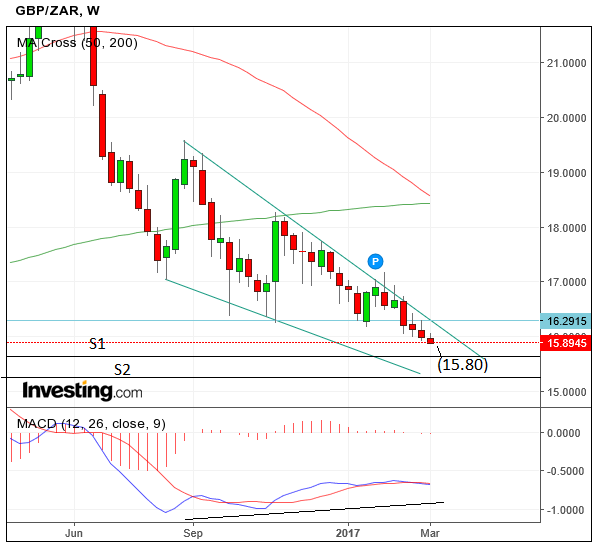South African Rand's Move Higher Against Sterling Becomes Increasingly Laboured

GBP/ZAR has now surpassed the 2016 October lows forged when hard Brexit fears were at their worst after Theresa May’s speech at the Conservative party conference.
Momentum is slowing, however, signalling the move down is becoming increasingly laboured.
Legendary trader Jesse Livermore once said: “Never short a dull market,” – a ‘short’ is a type of trade which makes money if the asset falls in value.
This is applicable to GBP/ZAR, however, given the trend has also not shown any signs of bullishness or a reversal we cautiously remain bearish.
This is not a conviction call, but the long-term downtrend is still very much dominant and likely to continue lower.
Support at 15.80 from the S1 monthly pivot, which is a level calculated from the Open, High, Low and Close of the month, is likely to lead to a bounce, and may even punctuate the downtrend.
If the rate breaks below that level (confirmed by a move below 15.75) we see a continuation down to the next support level from S2 at 15.35.

Data for the Rand
As far as broad themes go, the Rand is more likely to be influenced by the politics of its counterparts in the coming week.
EUR/ZAR and GBP/ZAR open at 13.833 and 16.025 respectively. EUR/ZAR will track EUR/USD for direction, which for now is still largely driven by French politics; sterling will take direction from Brexit discussion,” Rand Merchant Bank’s (RMB’s) Isaah Mhlanga
From a data perspective, the SARB’s gross reserves are out on Tuesday morning at 06.00 GMT and local Q4 GDP figures are due at 09.30.
Markets are expecting the economy to show 0.5% growth quarter-on-quarter (qoq) after 0.2% in Q3.
Year-on-year they are forecasting 0.6% from 0.7% in Q4 2016, although some analysts think this is overoptimistic.
Data for Sterling
Taxes could rise - probably putting pressure on Sterling - if Philip Hammond’s fulfills expectations with his budget on Wednesday.
The Chancellor appears to be in belt-tightening mode, according to recent news reports, which if we take them to be true (and not a strategic leak set to wrongfoot the market) would have him operating at complete odds to our cousins across the pond who are in spending mode.
This would propel GBP/USD lower for one, and possibly even GBP/ZAR too.
Consumer habits will come up for inspection on Tuesday, March 7 the Retail Sales Monitor from the British Retail Consortium (BRC) is released.
It is a survey rather than a hard data release but sentiment indicators are still often quite reliable of future activity.
The monitor, out at 00.01 (GMT), is expected to show a 0.2% rise in February from the -0.6% decline in Jan.
Overall, recent UK data has been described as soft, and this combined with the resurfacing of fresh Brexit risks relating to calls for a Scottish referendum are have been weighing on Sterling.
Whilst the cost to England of a Scottish break off have not yet been estimated by analysts there is an argument to say they may be roughly balanced with the gains since Scotland enjoys a disproportionate slice of the budget for its size.
Nevertheless, currently, the market is of the opinion that the related uncertainty caused by Scotland is negative for Sterling so more losses may be on the horizon as the narrative unfolds.
“Sterling fell hard this week as data took a turn for the worse. After a month of very narrow trading ranges, sterling finally broke down on the heels of softer data. Aside from slower service-sector activity, manufacturing activity also eased in February and between the stronger U.S. dollar, Scotland pushing for another referendum vote and Brexit's Article 50 later this month, it was only a matter of time before the bottom underneath sterling fell out. Now that support has been broken, we anticipate further losses in GBP,” commented Managing Director of BK Asset Management, Kathy Lien in a recent note seen by PSL.
